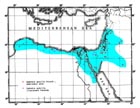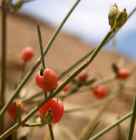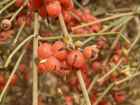
Distribution showing collection localities and inferred range. Basemap and collection localities redrafted from Freitag and Maier-Stolte (1989).

Ephedra aphylla growing in Wadi Degla, Egypt (29.9386°N, 31.3665°E) [Moshira Hassan, 2008].

Ephedra aphylla, same location, plant covered in mature cones [Moshira Hassan, 2008].

Ephedra aphylla same location, detail of mature cones [Moshira Hassan, 2008].

Ephedra aphylla same location, detail of mature cones [Moshira Hassan, 2008].

Conservation Status

Ephedra aphylla
Forssk. 1775
Common names
Taxonomic notes
Syn. Ephedra altissima Delile 1814; E. alte C. Meyer 1846 (Danin and Hedge 1973, Freitag and Maier-Stolte 1989). The type material of E. alte was found to be a mixture of male E. aphylla and female E. foliata Boiss. ex C. Meyer.
First collected by Forsskål in 1763 at Rosetta in Egypt, no type material has survived, and a neotype, Bornmüller 1749 from Jaffa, Israel, 1897.05.12, was designated by Freitag and Maier-Stolte (1989).
Description
Danin and Hedge (1973) present the following key to the four Ephedra species of the Sinai:
1. | Shrubby decumbent plants up to 1 m high; scarious leaf sheath, at least of young shoots, 1-2 mm long, as long as the diameter of the subtended stem and longer than leaf rudiments. | 2 |
+ | Climbing or prostrate plants often with long lignified stems; if forming a shrub (after grazing), scarious sheath shorter than diameter of subtended stem, and shorter than leaves. | 3 |
2. | Bracts of fruiting involucre 10-12, membraneous, obovate, with erose margin never becoming fleshy, free to base, anthers 3-5, stalked. Plants of sandy plains, chalky or gravelly wadis from 100 to 1400 m [elevation]. | E. alata |
+ | Bracts of fruiting involucre 6-8, becoming fleshy (but rarely developing in Sinai), adpressed with entire margin, pairs with connate base; anthers 6-10, sessile; female flowers mostly with one nutlet. Chasmophytes, growing in smooth-faced granite outcrops and hanging from granite cliffs; on highest peaks in narrow stony gorges from 1440 to 2600 m [elevation]. | E. pachyclada |
3. | Fleshy ripe fruiting bracts red, free part of leaf mostly less than 3 mm long, flowering branchlets always from thicker stems with green bark; general colour green. | E. aphylla |
+ | Fleshy ripe fruiting bracts white to grey, free part of leaf 3-10(-30) mm long; flowering branchlets mostly from stems with grey-white bark; general colour grey-glaucous green. | E. foliata |
In habit, it is somewhat peculiar. It is normally a shrub not over 1.4 m tall, but where it grows with taller vegetation, such as along irrigation ditches, it may grow into those plants as a scandent liana (Freitag and Maier-Stolte 1989).
Distribution and Ecology
Libya, Egypt, Saudi Arabia, Israel, Jordan. West of Palestine, it is the only Ephedra within its range (Freitag and Maier-Stolte 1989). Range may be somewhat more extensive, but I have found references to its occurrence in these countries. E. aphylla grows, among other places, in the south Sinai in rocky gorges and in fissured rocks (Danin and Hedge 1973). It occurs in diverse habitats, though, such as on cliffs, along wadis, and with phreatophytes along irrigation ditches (Freitag and Maier-Stolte 1989). The type location was from Rosetta in Egypt (Danin and Hedge 1973).
Remarkable Specimens
No data as of 2023.03.03.
Ethnobotany
Observations
See the observations on iNaturalist, accessed 2021.12.29.
See the photographs for the precise location of one occurrence, in Egypt.
Remarks
The epithet aphylla (Latin) means "leafless."
This and E. foeminea are the only two insect-pollinated species of Ephedra, a character they also share with Gnetum and Welwitschia. The pollinators are attracted by nectar droplets exuded by both male and female flowers. All other Ephedra are wind-pollinated, likely an adaptation to their windy, semiarid habitats (Rydin and Bolinder 2015).
Peter Forskål, a pupil of Linnaeus, was botanist on the Royal Danish Expedition to Egypt and the Yemen 1761-67. Forskål died of malaria in Yemen in July 1763, and his extensive collection of botanical and zoological specimens from Egypt and Saudi Arabia was sent back to Copenhagen. Niebuhr, the expedition cartographer, was the only survivor. The flora, posthumously published by Niebuhr, described for the first time a large number of Arabian plants.
Citations
Danin, A. and I.C. Hedge. 1973. Contributions to the flora of Sinai I: new and confused taxa. Notes from the Royal Botanic Garden Edinburgh 32:259-271.
Forsskål, P. 1775. Flora Aegyptiaco-arabica. Hauniae, ex officia Möller, p. 170. Available: Biodiversity Heritage Library, accessed 2021.12.26.
Freitag, H. and M. Maier-Stolte. 1989. The Ephedra-species of P. Forsskål: Identity and typification. Taxon 38(4):545-556.
Rydin, C. and K. Bolinder. 2015. Moonlight pollination in the gymnosperm Ephedra (Gnetales). Biology Letters, doi.org/10.1098/rsbl.2014.0993.
See also
Flora of Israel Online, accessed 2008.06.19.
Hepper, F.N. and I. Friis. 1994. The plants of Pehr Forsskål's Flora Aegyptiaco-Arabica. Kew Publishing.
Species profile at Plants of the World Online, accessed 2021.12.29.





